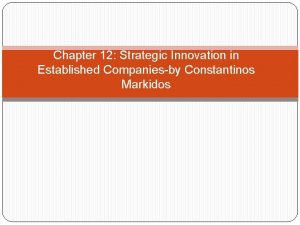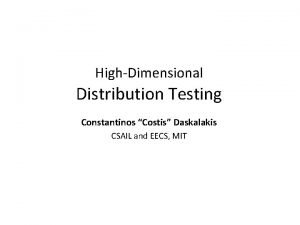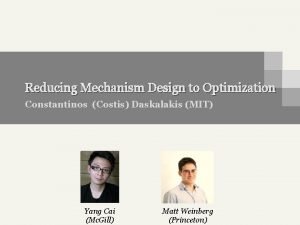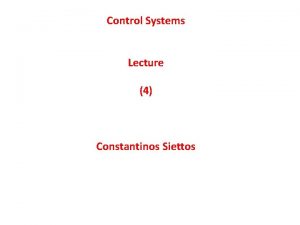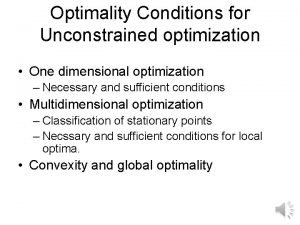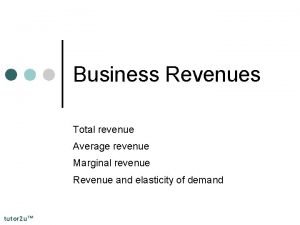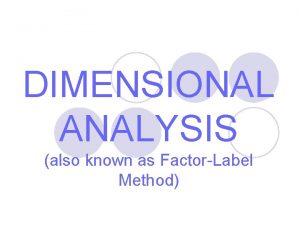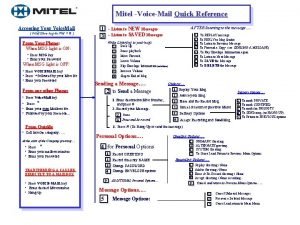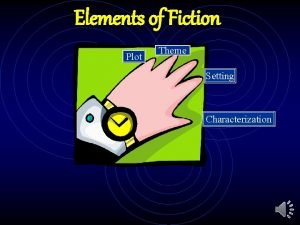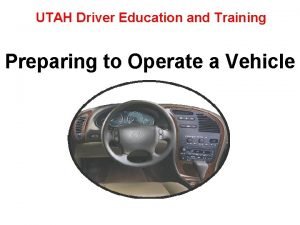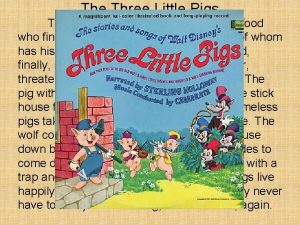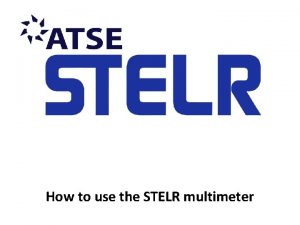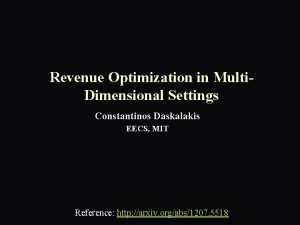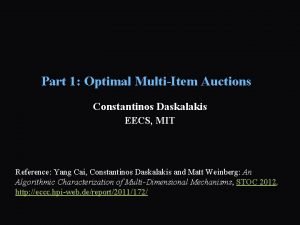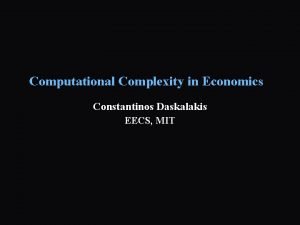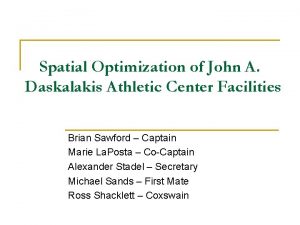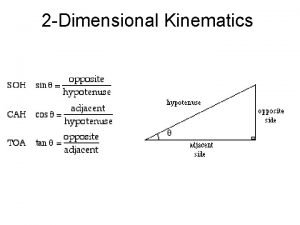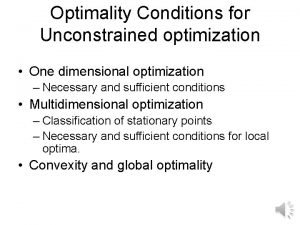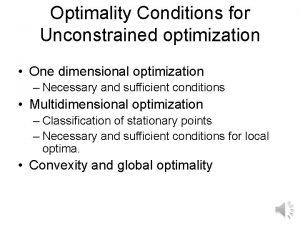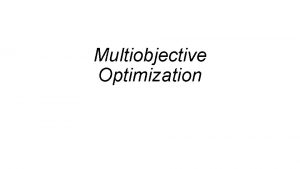Revenue Optimization in Multi Dimensional Settings Constantinos Daskalakis














![Welfare-Optimization ► [Vickrey-Clarke-Groves]: Mechanism design for welfare-optimization is no harder than algorithm design for Welfare-Optimization ► [Vickrey-Clarke-Groves]: Mechanism design for welfare-optimization is no harder than algorithm design for](https://slidetodoc.com/presentation_image_h2/c69e0e18bf39d7e74f635388f472e2dd/image-15.jpg)
![Revenue-Optimization ► [Myerson ’ 81]: In all single-dimensional (i. e. single-item / single-item multi-unit) Revenue-Optimization ► [Myerson ’ 81]: In all single-dimensional (i. e. single-item / single-item multi-unit)](https://slidetodoc.com/presentation_image_h2/c69e0e18bf39d7e74f635388f472e2dd/image-16.jpg)

![Multi-Dimensional Auction Phenomena (2) [Thanassoulis’ 04]: - optimal deterministic mechanism: post price of $5. Multi-Dimensional Auction Phenomena (2) [Thanassoulis’ 04]: - optimal deterministic mechanism: post price of $5.](https://slidetodoc.com/presentation_image_h2/c69e0e18bf39d7e74f635388f472e2dd/image-18.jpg)

![Setting paintings Previous Results OPT: [Cai-D-Weinberg STOC’ 12] (matroid) houses (matching) doctor appointments (downwards-closed) Setting paintings Previous Results OPT: [Cai-D-Weinberg STOC’ 12] (matroid) houses (matching) doctor appointments (downwards-closed)](https://slidetodoc.com/presentation_image_h2/c69e0e18bf39d7e74f635388f472e2dd/image-20.jpg)






















- Slides: 42

Revenue Optimization in Multi. Dimensional Settings Constantinos Daskalakis EECS, MIT Reference: http: //arxiv. org/abs/1207. 5518

► ► Revenue-optimization, so far Jason’s talk: § Bayesian mechanism design: Auction design in presence of stochastic information about the bidders. § Analysis tools: Bayes-Nash equilibrium. § Single-dimensional setting: 1 type of item, many bidders, constraints on who can be given an item simultaneously. § [Myerson’ 81]: Revenue-optimal auction in all single-dimensional settings. ► In fact, a reduction from auction- design to algorithm- design: Revenue optimization reduces to (virtual) welfare optimization. Tim’s talk: § Single-dimensional settings are not only optimally solvable, but also amenable to simple approximations. § “Exist constant-factor approximations which use little information about the bidders. ”

Beyond Single-Dimensional Settings online marketplaces - heterogeneous items - complicated allocation constraints sponsored search online inventory allocation spectrum auctions

Multi-dimensional Auction Setting 1 1 … … j i … … m n - Bidders have values on items and bundles of items. - Bidder’s valuation (or type) encodes that information. revenue/social welfare/other objective

Example Valuations - Example 1: Additive bidder - described by vector of values - their valuation is: (one value per item) - Example 2: Single-minded combinatorial bidder - described by the subset of items they desire S, and their value v - their valuation is: è For simplicity, throughout talk assume bidders are additive.

Multi-dimensional Auction Setting 1 … … j i - … … m revenue/social welfare/other objective 1 n universe of possible valuations for bidder i Bidders have values on items and bundles of items. Bidder’s valuation (or type) encodes that information. additive bidder: Bidders’ types (t 1, …, tm) come from known product distribution .

Multi-dimensional Auction Setting 1 … … j i - … … m revenue/social welfare/other objective 1 n universe of possible valuations for bidder i Bidders have values on items and bundles of items. Bidder’s valuation (or type) encodes that information. additive bidder: Bidders’ types (t 1, …, tm) come from known product distribution - Auctioneer will decide some allocation A [m] x [n], and charge prices. - There are (possibly combinatorial) constraints on what allocations are allowed. .

Example 1: selling paintings 1 1 … … j i … … m n - Items are paintings. - No painting should be given to more than one bidder - so:

Example 2: selling houses 1 1 … … j i - … … m n Items are houses. No house should be given to more than one bidder. No bidder should receive more than one house. so:

Example 3: selling doctor appointments 1 1 … … i j … … m n - Items are slots with doctors in a hospital. - No slot should be given to more than one bidder. - No bidder should get more than one slot with same doctor, or overlapping slots with different doctors.

Example 4: building bridges 1 … i … m - Items are possible locations for building a bridge L = {l 1, l 2, …, ln}. - If a location is given to one bidder, it is given to all bidders (as every bidder will use a bridge if it is built). - so:

Multi-dimensional Auction Setting revenue/social welfare/other objective 1 1 … … j i … … m n universe of possible valuations for bidder i - Bidders have values on items and bundles of items. - Bidder’s valuation (or type) encodes that information. - Bidders’ types (t 1, …, tm) come from known product distribution . - Auctioneer will decide some allocation A [m] x [n], and charge prices. - There are (possibly combinatorial) constraints on what allocations are allowed. - INPUT: m, n, T 1, …, Tm , , and some access to .

Auction in Action 1 1 expected welfare: … … i expected revenue: - chosen j by auction - Commits to an auction design, specifying allowed over bidders’ types t 1(i) , …, tm, the bidder actions, (ii)the allocation price rule; randomness in the auction, and (iii)the bidders’ - in Asks bidders play the auction; strategies Bayes Nashtoequilibrium - Implements the allocation and price n rule specified by the auction; - Goal: Optimize revenue/welfare. payment made by bidder i to the auctioneer Uses as input: the auction specification, her own type, and her beliefs about over bidders’ types t 1, …, tm, the types of the other bidders; randomness in the auction, and the bidders’ Chooses how to play; strategies in Bayesbundle Nash equilibrium Goal: optimize her own utility (= value for allocated – price charged). Each Bidder: - … … m outcome in Auctioneer:

background welfare vs revenue optimization in multidimensional settings
![WelfareOptimization VickreyClarkeGroves Mechanism design for welfareoptimization is no harder than algorithm design for Welfare-Optimization ► [Vickrey-Clarke-Groves]: Mechanism design for welfare-optimization is no harder than algorithm design for](https://slidetodoc.com/presentation_image_h2/c69e0e18bf39d7e74f635388f472e2dd/image-15.jpg)
Welfare-Optimization ► [Vickrey-Clarke-Groves]: Mechanism design for welfare-optimization is no harder than algorithm design for welfare-optimization. ► the VCG auction (as a reduction): § bidders are asked to report their types: t 1, t 2, …, tm ; § the mechanism chooses the allocation ► obtained ; via a call to a welfare optimization algorithm § bidders are charged so that: reported types = true types. ► truthfulness-inducing payments can be computed via calls to a welfare optimization algorithm (e. g. Clarke pivot payments) Corollary: the only bottleneck to tractable welfare-optimizing mechanisms is whethere is a computationally efficient algorithm for the underlying welfare optimization problem. ► Approximation preserving mechanism-to-algorithm reduction ? ► § yes! [Hartline-Lucier’ 10, Hartline-Kleinberg-Malekian’ 11, Bei-Huang’ 11] § Spoiler Alert: Nicole will present these results.
![RevenueOptimization Myerson 81 In all singledimensional i e singleitem singleitem multiunit Revenue-Optimization ► [Myerson ’ 81]: In all single-dimensional (i. e. single-item / single-item multi-unit)](https://slidetodoc.com/presentation_image_h2/c69e0e18bf39d7e74f635388f472e2dd/image-16.jpg)
Revenue-Optimization ► [Myerson ’ 81]: In all single-dimensional (i. e. single-item / single-item multi-unit) settings, mechanism design for revenue optimization reduces to algorithm design for welfare optimization. ► Myerson’s auction (as a reduction): § bidders are asked to report their types ; § reported types are transformed to virtual-types ; § the virtual-welfare maximizing allocation is chosen; ► this is a call to a welfare optimization algorithm § and prices are charged to make sure bidders report truthfully. ► truthfulness-inducing payments can be computed via calls to a welfare optimization algorithm Corollary: If the underlying welfare-maximization problem is tractable, then so is the revenue-optimal auction. ► Unanswered: Beyond single-item settings? Robustness to approximation; ► ► Myerson’s proof is “mystical; ” result comes mysteriously out of algebra…

Multi-Dimensional Auction Phenomena optimal mechanism: sell item for 1/2 expected revenue: 1/4 optimal mechanism ? idea 1: run n different auctions as above … … additive expected revenue: n/4 idea 2: offer the grand bundle of all the items at price expected revenue: moral of the story: bundling helps
![MultiDimensional Auction Phenomena 2 Thanassoulis 04 optimal deterministic mechanism post price of 5 Multi-Dimensional Auction Phenomena (2) [Thanassoulis’ 04]: - optimal deterministic mechanism: post price of $5.](https://slidetodoc.com/presentation_image_h2/c69e0e18bf39d7e74f635388f472e2dd/image-18.jpg)
Multi-Dimensional Auction Phenomena (2) [Thanassoulis’ 04]: - optimal deterministic mechanism: post price of $5. 097 on each item expected revenue: $5. 05 unit demand - a better randomized mechanism additionally sell for $5. 057 the lottery (1/2, 1/2) expected revenue: $5. 06 moral of the story: randomization helps [Briest-Chawla-Kleinberg-Weinberg’ 10]: gap may be arbitrarily high in general [Chawla-Malec-Sivan’ 10]: for independent values, unit-demand bidders, gap is at most a factor of 34.

Multi-dimensional Mechanisms (known results prior to FOCS’ 12) ► Large body of work in Economics: multi- to single§ [Mc. Afee-Mc. Millan’ 88], [Wilson’ 93], [Armstrong’ 96], [Rochet-Chone’ 98], dimensional reduction [Armstrong’ 99], [Zheng’ 00], [Basov’ 01], [Kazumori’ 01], [Thanassoulis’ 04], [Vincent-Manelli’ 06], [Vincent-Manelli’ 07], … § Progress sporadic. ► Recently (2007 -today), algorithmic tools enabled progress. § constant-factor approximations (limited settings) ► [Chawla-Hartline-Kleinberg ’ 07], [Chawla et al’ 10], [Bhattacharya et al’ 10], [Alaei’ 11], [Hart-Nisan ’ 12], [Kleinberg-Weinberg ’ 12], [Alaei et al’ 12] § exact solutions (limited settings) ► [Cai-D ’ 11], [D-Weinberg ’ 12], [Cai-D-Weinberg ’ 12 a], [Alaei al ’ 12], multitoetsingle[Cai-Huang’ 13] § “limited settings”: ► additive bidder reductions bidders and no allocation constraints ► unit-demand bidders and matroid constraints on who can be served
![Setting paintings Previous Results OPT CaiDWeinberg STOC 12 matroid houses matching doctor appointments downwardsclosed Setting paintings Previous Results OPT: [Cai-D-Weinberg STOC’ 12] (matroid) houses (matching) doctor appointments (downwards-closed)](https://slidetodoc.com/presentation_image_h2/c69e0e18bf39d7e74f635388f472e2dd/image-20.jpg)
Setting paintings Previous Results OPT: [Cai-D-Weinberg STOC’ 12] (matroid) houses (matching) doctor appointments (downwards-closed) APPX: [A, BGGM, CHMS, KW] OPT: OPEN APPX: OPEN bridges OPT: OPEN

Challenge ► Revenue optimization in general multi-item settings. § ideally: (i) unified solution for all settings § (ii) Robustness of solutions to approximation, complexity.

A General Solution ► A generic reduction: § Mech. for Revenue Optimization Alg. for Welfare Optimization ► [Cai-D-Weinberg FOCS’ 12]: Suppose that: § bidder types are independent; § [the number of bidders m, items n, and the set-system allocations are unrestricted. ] of feasible then the revenue-optimal auction can be computed with queries to a welfare-optimization algorithm A for. ► The optimal auction has the following form: ► § § § bidders are asked to report their types; reported types are transformed into virtual types via bidder-specific functions; the virtual-welfare optimizing allocation in is chosen with a call to A; prices are charged to enforce truth-telling in Nash equilibrium. in Myerson’s theorem: virtual function = deterministic, closed-form here, randomized, computed during execution of Ellipsoid.

A General Solution ► A generic reduction: § Mech. for Revenue Optimization Alg. for Welfare Optimization ► [Cai-D-Weinberg FOCS’ 12]: Suppose that: § bidder types are independent; § [the number of bidders m, items n, and the set-system allocations are unrestricted. ] of feasible then the revenue-optimal auction can be computed with queries to a welfare-optimization algorithm A for. ► The optimal auction is a virtual welfare maximizer. ► Corollary: If the underlying welfare-maximization problem for is tractable (ignoring incentives), then so is the revenue-optimal auction. ►

Today’s menu General Auction Setting Background on Optimal MD Challenge, General Result Some Technical Ideas Combinatorial Optimization Viewpoint

Specifying an auction (explicit but expensive) ► via the ex-post allocation & price rule: : probability distribution over feasible sets from which allocation is chosen when bidders’ types are : price that bidder i pays under type profile ► ► ► description size: feasibility trivial to check (in fact hardwired into A) Folklore: can write LP on A and P to find a revenue-optimal auction why? expected revenue is linear in P, truthfulness constraints linear in A, P trouble: exponentially many variables § solving LP takes exponential time § solution is bad: “laundry-list” auction

Specifying an auction (lossy and still expensive) ► via the ex-post allocation probabilities: : marginal probability that item j is allocated to bidder i when bidders’ types are : price that bidder i pays when bidders’ types are description size still prohibitive: ► and feasibility is hard to check now efficiently: ► 1. is there a distribution over feasible allocations with these marginals, in view of the possibly combinatorial constraints on feasible allocations given by ? 2. bright exception: for simple allocation constraints, e. g. matching constraints, checking feasibility is easy using the Birkhoff-von Neumann theorem. ► can’t write LP anymore and, even if I could, its solution would be useless.

the reduced form of an auction ► a. k. a. the interim allocation & price rule : : marginal allocation probability of item j to bidder i when his type is ti (over the randomness in the other bidders’ types, and the randomness in mechanism) : expected price paid by bidder i when his type is ti (over the other bidders’ types, and the randomness in the mechanism) description size: ; ► c. f. description complexity of ex-post allocation rule ; ► feasibility hard to check: 1. Can the per-bidder marginal probabilities be reconciled? 2. …in a way that also respects the allocation constraints given by ? i. e. when can interim probabilities be converted to a feasible mechanism? ► wishful thinking: what if we could check feasibility efficiently? ►

Mechanism Design with the Reduced Form Variables: expected value of bidder i of type for being given (additivity of bidders) the reduced form of sought auction Constraints: Bayesian Nash Equilibrium: Objective: - the expected revenue - Need: (i) Separation oracle for feasible reduced forms - (ii) Efficient map from feasible reduced form to mechanism (optimal feasible reduced form is useless in itself)

feasibility of reduced forms

Feasibility of Interim Rules (example) easy setting: single item, two bidders with types uniformly distributed in T 1={A, B} and T 2={C, D} respectively ► allocation constraints = item cannot be given to more than one bidder ► Question: Are the following interim allocation probabilities feasible? ► bidder 1 ½ A ½ B so i ib s a e nf le ! C ½ bidder 2 D ½ whenever types are A, C: A needs to get item whenever types are A, D: A needs to get item type A satiated whenever types are B, C: C needs to get item type C satiated whenever types are B, D: B needs to get item with prob. 0. 4 and D needs to get item with prob. 0. 8

Feasibility of Interim Rules - Single-item reduced forms: - [Border ’ 91, Border ’ 07, CKM ’ 11]: Necessary and sufficient conditions. - linear constraints OR separation oracle w/ runtime - [Cai-D-Weinberg’ 12, Alaei et al ’ 12]: SO w/ runtime . . - Any hope for multi-item reduced forms, w/ arbitrary allocation constraints - [Cai-D-Weinberg FOCS’ 12 ]: Given black-box access to max-welfare algorithm for can decide feasibility of reduced-forms efficiently. Moreover, given feasible reduced form can efficiently find a mechanism with this reduced form. - the combinatorial optimization perspective - geometric view: ?

Feasibility of Interim Rules Claim 1: set of feasible interim rules Claim 2: Given max-welfare algorithm for allocation constraints can find a separation oracle for (and vice versa). MD version of Grötschel-Lovász-Schrijver equivalence of optimization and separation Claim 3: Every vertex of the polytope is the reduced form of a virtual welfare maximizing allocation rule.

Characterizing the Vertices

Characterizing the Vertices virtual welfare maximizing interim rule “in direction ” expected virtual welfare achieved by allocation rule with interim rule interpretation: virtual value derived by bidder i when given item j, if his type is A

Characterizing the Vertices A virtual VCG allocation rule is defined by virtual functions , where , for all i. virtual welfare maximizing It takes a type-vector t 1, t 2, interim ruleas “ininput direction ” …, tm - transforms it into the virtual type-vector - then optimizes welfare using virtual types instead of true ones Q: OK understood what corner does, but what mechanism has this A: The VCG mechanism w/ virtual functions f 1, …, fm interpretation: virtual value derived by bidder i when given item j, if his type is A ?

Characterizing the Vertices is a polytope whose corners are implementable by virtual VCG allocation rules. [CDW ’ 12]: The interim allocation rule of any feasible mechanism can be implemented as a distribution over virtual VCG allocation rules.

Feasibility of Interim Rules set of feasible interim rules Claim 1: We can optimize over the set of feasible reduced forms, using the ellipsoid algorithm. The optimal reduced form can be converted to a convex combination of max-welfare computations. Claim 2: Given max-welfare algorithm for allocation constraints can find a separation oracle for (and vice versa). MD version of Grötschel-Lovász-Schrijver equivalence of optimization and separation Claim 3: Every vertex of the polytope is the reduced form of a virtual welfare maximizing allocation rule.

Reality Check ► Connection to Grötschel-Lovász-Schrijver § Wishful thinking: given algorithm for welfare optimization under allocation constraints , can get linear optimization algorithm for. § Reality: Can’t do this efficiently; but can get additive-approx FPTAS. § Trouble: GLS requires exact linear optimization, and its extensions multiplicative approximations. § Solution: Specialized for MD. § Our result provides an extension of GLS to additive approximation algorithms, exploiting the structure of. ► End product: FPRAS § OPT-ε revenue, in time poly(1/ε). § [This still happens at BNE and not ε-BNE]

De-mystifying Myerson ► Unexpected properties of Myerson’s optimal single-item auction: § the auction is deterministic (no internal coin-flips) ; § while it is optimal among all auctions, it is itself a Dominant Strategy Truthful auction. ► Through our combinatorial optimization perspective we can easily show that § for all single-dimensional settings; and § for all objective functions that are linear in the interim rule (e. g. welfare, revenue, linear combinations thereof) the optimal auction is deterministic, DST, and a virtual welfare maximizer. ► Why? The optimal solution of the LP must be a corner. (No regularity assumption or ironing is needed for the argument. )

Summary ► Welfare optimization is a well-understood problem: § the VCG auction provides a reduction from mechanism to algorithm design ► The same is not true for revenue: § Myerson’s auction optimizes revenue in single-dimensional settings; § but multi-item settings are not well understood. ► I showed a general result providing the natural generalization of Myerson’s theorem to all multi-item settings. § “The revenue optimal auction is a virtual-welfare maximizer; which can be computed with polynomially many queries to a welfare-maximizing algorithm. ” ► Techniques: geometry, ellipsoid algorithm; § can optimize over reduced forms using welfare algorithm as a separation oracle.

Further Results/Open Problems ► Approximation Preserving reduction? § Given a-approximation for welfare, can obtain a-approximation for revenue? § Yes [Cai-D-Weinberg SODA’ 13]; § Complication: Can’t get separation oracle for polytope of reduced forms from approximation algorithm for welfare. size of support of bidder i’s type-distribution ► Implicit type-distributions? § our running-time is polynomial in ; § but suppose type-distribution is given implicitly ► e. g. consider additive bidder whose value for item j is uniform in {aj, bj} independently of other items § Q: can running time be improved for such implicit disn’s? § [D-Deckelbaum-Tzamos]: Problem is #P-hard even when there is a single additive bidder whose values are independent, rational, of support two. § But FPTAS still not precluded.

Further Results/Open Problems ► Nature of Virtual Functions § § ► both Myerson’s auction and its generalization are virtual welfare maximizers; Myerson provided a closed formula for each bidder’s virtual function; in the generalized auction, the virtual functions are computed by an algorithm; any structure for simple multi-item settings? Value Oracle Model? § in our work valuations in support are described explicitly; § what if valuations are implicit? ► i. e. given S, a circuit outputs value of bidder for subset S of items § Problem is NP-hard in general [Dobzinski-Fu-Kleinberg’ 11] § but what if valuations have structure? Thanks for listening
 Costis daskalakis
Costis daskalakis Costis daskalakis
Costis daskalakis Costis daskalakis
Costis daskalakis Constantinos kc
Constantinos kc Constantinos christofides
Constantinos christofides Constantinos filis
Constantinos filis Unimodal function
Unimodal function One dimensional unconstrained optimization
One dimensional unconstrained optimization A circular motion is one dimensional
A circular motion is one dimensional Average
Average Contoh array 2 dimensi python
Contoh array 2 dimensi python Factor label method steps
Factor label method steps Waiting line management
Waiting line management Multi loop pid controller regolatore pid multi loop
Multi loop pid controller regolatore pid multi loop Beowulf setting
Beowulf setting Vray sun turbidity
Vray sun turbidity Ethernet duplex settings
Ethernet duplex settings Mitel smtp settings
Mitel smtp settings What is the setting of the story beowulf
What is the setting of the story beowulf Charles by shirley jackson conflict
Charles by shirley jackson conflict Lord of the flies settings
Lord of the flies settings Jo neary
Jo neary Copyright
Copyright Elements of theme
Elements of theme Traditional mirror settings should be used
Traditional mirror settings should be used Setting of three little pigs
Setting of three little pigs Startlogic imap settings
Startlogic imap settings Stelr wind turbine
Stelr wind turbine Bge mirror settings
Bge mirror settings The limitations of deep learning in adversarial settings
The limitations of deep learning in adversarial settings Learner participation in educational settings
Learner participation in educational settings Hudson prongs
Hudson prongs Healthcare settings
Healthcare settings Multiple probe vs multiple baseline
Multiple probe vs multiple baseline Setting comedy
Setting comedy The alchemist setting
The alchemist setting Falling action definition literature
Falling action definition literature Setting time and place example
Setting time and place example Avaps ae meaning
Avaps ae meaning Define ventilation
Define ventilation Vray ies light settings
Vray ies light settings Https://www.google.com/settings/dashboard
Https://www.google.com/settings/dashboard The elements of a folktale
The elements of a folktale
